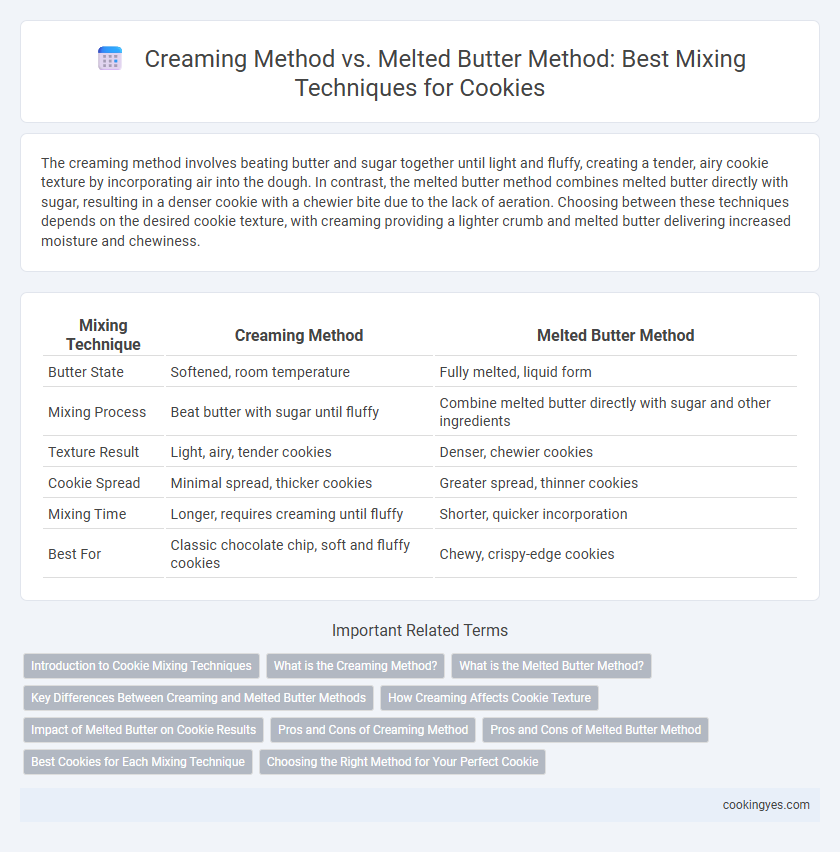The creaming method involves beating butter and sugar together until light and fluffy, creating a tender, airy cookie texture by incorporating air into the dough. In contrast, the melted butter method combines melted butter directly with sugar, resulting in a denser cookie with a chewier bite due to the lack of aeration. Choosing between these techniques depends on the desired cookie texture, with creaming providing a lighter crumb and melted butter delivering increased moisture and chewiness.
Table of Comparison
| Mixing Technique | Creaming Method | Melted Butter Method |
|---|---|---|
| Butter State | Softened, room temperature | Fully melted, liquid form |
| Mixing Process | Beat butter with sugar until fluffy | Combine melted butter directly with sugar and other ingredients |
| Texture Result | Light, airy, tender cookies | Denser, chewier cookies |
| Cookie Spread | Minimal spread, thicker cookies | Greater spread, thinner cookies |
| Mixing Time | Longer, requires creaming until fluffy | Shorter, quicker incorporation |
| Best For | Classic chocolate chip, soft and fluffy cookies | Chewy, crispy-edge cookies |
Introduction to Cookie Mixing Techniques
The creaming method involves beating butter and sugar together until light and fluffy, which incorporates air for a tender, airy cookie texture. In contrast, the melted butter method combines warm butter directly with sugar, producing denser, chewier cookies with a richer flavor. Both techniques influence cookie spread, crumb structure, and overall mouthfeel, making the choice crucial depending on the desired cookie outcome.
What is the Creaming Method?
The creaming method involves beating softened butter and sugar together until light and fluffy, which incorporates air into the mixture to create a tender, airy cookie texture. This technique allows leavening agents like baking soda or baking powder to activate more effectively, resulting in cookies with a well-developed crumb and controlled spread. In contrast to the melted butter method, creaming produces a thicker dough that yields cookies with a soft interior and slightly crisp edges.
What is the Melted Butter Method?
The Melted Butter Method involves melting butter before mixing it with sugar, resulting in a denser, chewier cookie texture compared to the Creaming method, which incorporates air for a lighter crumb. This technique allows for easier integration of ingredients and produces cookies with a moist consistency and a rich, caramelized flavor. Bakers often choose melted butter to achieve a fudgy interior and crispy edges in their cookie recipes.
Key Differences Between Creaming and Melted Butter Methods
The creaming method incorporates air by beating softened butter with sugar, resulting in a lighter, fluffier cookie texture, while the melted butter method produces denser, chewier cookies due to the liquid fat being mixed directly with sugars. Creaming requires more mixing time to develop structure and lift, whereas melted butter recipes mix quickly but yield less volume and spread more during baking. The choice between these methods significantly influences cookie texture, spread, and crumb consistency.
How Creaming Affects Cookie Texture
Creaming butter and sugar incorporates air into the dough, creating a lighter and fluffier cookie texture with a tender crumb. This method promotes even leavening and enhances the formation of a consistent crumb structure, resulting in cookies that are soft yet hold their shape. In contrast, the melted butter method produces denser, chewier cookies due to reduced aeration and increased moisture distribution.
Impact of Melted Butter on Cookie Results
Melted butter in cookie dough creates a denser, chewier texture by promoting greater gluten development and spreading during baking. This method results in cookies with a richer, more intense buttery flavor and crispier edges compared to the lighter, fluffier texture achieved using the creaming method. The increased fat liquidity in melted butter also enhances moisture retention, contributing to a tender interior and prolonged freshness.
Pros and Cons of Creaming Method
The creaming method, a popular cookie mixing technique, involves beating butter and sugar together to incorporate air, resulting in lighter, fluffier cookies with a tender crumb. This method ensures better texture and volume but requires more time and effort compared to the melted butter method. However, the creaming process can be sensitive to ingredient temperature and overmixing, potentially leading to inconsistent cookie spread and texture.
Pros and Cons of Melted Butter Method
The melted butter method for mixing cookie dough offers a denser, chewier texture and faster preparation by quickly combining ingredients, making it ideal for moist, rich cookies. However, this technique can reduce the cookie's fluffiness and cause spreading, which might result in thinner, crispier edges that some may find less desirable. Bakers seeking a softer, cake-like crumb might prefer alternatives, as melted butter lacks the aeration benefits of creamed butter.
Best Cookies for Each Mixing Technique
The creaming method, which combines softened butter and sugar to incorporate air, produces cookies with a light, tender texture ideal for classic chocolate chip or sugar cookies. In contrast, the melted butter method yields denser, chewier cookies, making it perfect for recipes like oatmeal or peanut butter cookies where a fudgier consistency is desired. Selecting the right mixing technique enhances the final cookie texture based on recipe-specific goals.
Choosing the Right Method for Your Perfect Cookie
The creaming method involves beating butter and sugar together to create a light, airy texture, resulting in cookies with a tender crumb and a slightly cakey consistency. In contrast, the melted butter method produces a denser, chewier cookie with a richer flavor due to the liquid fat integrating more thoroughly with the sugar and flour. Selecting the right mixing technique depends on your desired cookie texture--opt for creaming when aiming for soft, fluffy cookies and melted butter for chewy, fudgy results.
Creaming method vs Melted butter method for mixing technique Infographic

 cookingyes.com
cookingyes.com